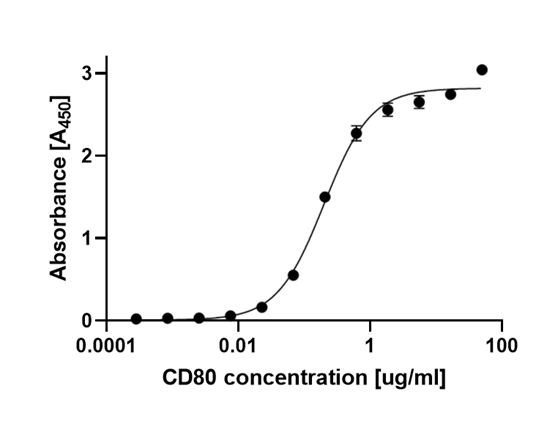T-lymphocyte activation antigen CD80
CD80
| Alternative names |
B7-1 |
| Known ligands |
CTLA-4, CD28 |
| Origin |
Homo sapiens |
| Accession number |
P33681 |
| R1-006-1 |
CD80 ECD (35 - 242) |
His-tag, Fc-tag |
CHO |
Yes |
ELISA, WB, functional studies |
| R1-006-1a |
CD80 ECD (35 - 242) |
His-tag |
CHO |
Yes |
ELISA, WB, functional studies |
| R1-006-2a |
CD80 for crystallization |
Tag free |
CHO |
Yes |
NMR, X-Ray |
ORDER NOW
T-lymphocyte activation antigen CD80 (CD80; B7-1) is type 1 transmembrane protein with an extracellular domain containing two Ig-like domains and shares ~25% sequence identity with its homolog CD86 (B7-2). (1) CD80 and CD86 are expressed on B‐cells, T‐cells, dendritic cells, and antigen presenting cells (APCs). (2) On APCs CD86 is constitutively expressed and upregulated in response to stimulation, while CD80 is later inducibly expressed. (2) (3) CD80, together with CD86 and B7-H2, serves as a ligand for CD28 and CTLA-4. (4) (5) Additionally CD80 can bind to PD-L1 with binding affinity being the strongest with CTLA-4, intermediate with PD-L1 and the lowest with CD28. (6) Binding of CD86, CD80 or B7-H2 to CD28 delivers a positive signal to T cells, in contrast, the interaction of CTLA-4 with B7 ligands attenuates T cell activation. (3) Also the interaction between CD80 and PD‐L1 provides an inhibitory signal, depicted by reduced T‐cell activation and cytokine production. (2) Interestingly CD80 and PD‐L1 can interact in the same cell as a mechanism to block interaction with PD‐1 or CTLA‐4 and corresponding T‐cell inhibition. (2) Blocking the CD80 interaction with CD28 is a target for the treatment of autoimmune diseases to facilitate organ transplantation and blocking the interactions with PD-L1 and CTLA-4 are targeted to restore antitumor responses (2)
- Lenschow DJ et al. CD28/B7 system of T cell costimulation. Annual Review of Immunology. 1996, Vol. 14, pp. 233–258.
- Chen et al. Targeting B7‐1 in immunotherapy. Medicinal Research Reviews. 2020, Vol. 40, 2, pp. 654-682.
- Bhatia S et al. Different cell surface oligomeric states of B7-1 and B7-2: Implications for signaling. PNAS. 2005, Vol. 102, 43, pp. 15569-15574.
- Azuma M et al. B70 antigen is a second ligand for CTLA-4 and CD28. Nature. 1993, Vol. 366, pp. 76–79.
- Chen L and Flies DB. Molecular mechanisms of T cell co-stimulation and co-inhibition. Nature Reviews Immunology. 2013, Vol. 13, 4, pp. 227-242.
- Butte MJ et al. Programmed death-1 ligand 1 interacts specifically with the B7-1 costimulatory molecule to inhibit T cell responses. Immunity. 2007, Vol. 27, 1, pp. 111-122.




